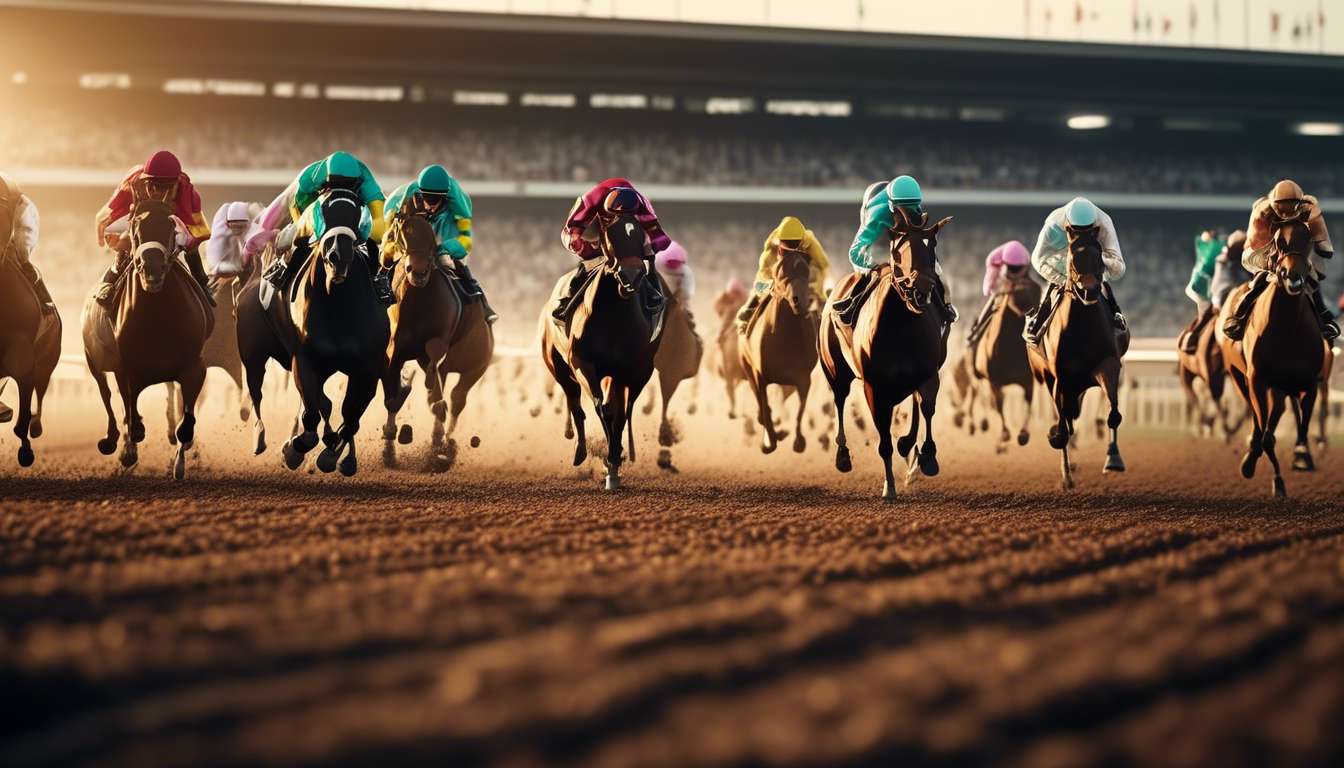In the thrilling world of horse racing, we often find ourselves captivated by the excitement of watching powerful steeds thunder down the track. As enthusiasts, we frequently hear terms like “a length” thrown around by commentators and experts, but how many of us truly understand what that means?
Together, we embark on a journey to unravel this common yet intriguing concept in horse racing. A “length” is not just a casual measurement; it’s a critical part of assessing races and determining outcomes.
Origins and Importance of "Length":
- The term "length" has historical roots in horse racing, serving as a standard measurement to compare the performance of different horses during a race.
- It represents the length of a horse from nose to tail, typically around 8 to 9 feet.
- Understanding this measurement is crucial for evaluating race results and making informed betting decisions.
Contexts and Calculations:
-
Finish Line:
- A length is used to describe the distance by which a horse wins or loses relative to another at the finish line.
-
Race Strategy:
- Jockeys and trainers use the concept of length to plan race strategies, determining when to conserve energy or push for the lead.
Influence on Betting and Race Strategies:
- Bettors analyze the lengths by which horses win or lose to predict future performances and make strategic wagers.
- Understanding lengths helps in comparing horses’ past performances and assessing their potential in upcoming races.
By exploring the origins and calculations of this term, we aim to enrich our appreciation for the sport. Join us as we navigate the intricacies of this measurement and enhance our collective understanding of the sport we all cherish so dearly.
Historical Roots of “Length”
The term "length" in horse racing originates from the early days of the sport when people needed a simple way to measure the distance between horses. This measurement provided a visual and relatable way to understand and discuss race outcomes without complex calculations.
We can imagine the excitement of those early races, where enthusiasts gathered with a shared passion. The length was not just a tool for spectators; it became essential for jockeys and trainers in planning their racing strategies with precision.
As we delve into the historical roots, we find that using the horse’s body as a unit of measurement fostered a sense of community. This shared language:
- Bridged gaps between different groups
- Brought people together, whether at the track or discussing results with friends
The concept of a "length" has always been more than just a measurement—it’s a connection to a rich history we all cherish.
Standard Measurement in Horse Racing
In horse racing, precise standards are used to measure a "length," ensuring consistency and fairness in determining race outcomes. This shared understanding helps us appreciate the strategies at play on the track, enhancing the thrill and camaraderie of the racing community.
A "length" is the standard unit of measurement used to describe the distance between horses in a race. It is roughly equivalent to the length of a horse from nose to tail, often standardized at about 8 feet. This consistent measurement is crucial for accurately gauging the performance of both horses and jockeys.
- Every fraction of a length can impact the race outcome.
- Precision in measuring lengths is essential.
Using this standard measurement allows trainers and jockeys to refine their strategies. By understanding how lengths translate to speed and positioning, they can make informed decisions during the race.
Together, we celebrate this shared understanding of racing dynamics, which enhances both the strategy and excitement of horse racing.
Significance in Race Evaluation
The Importance of "Length" in Horse Racing
In evaluating races, the concept of "length" is crucial for accurately assessing horse performance and final race outcomes. This measurement provides a tangible way to compare how tightly contested a race was and aids in strategizing future races.
Role of Length in Race Strategy
- Length is not just about the distance a horse wins or loses by.
- It is a critical factor that influences race strategy and decision-making processes.
By understanding the role of lengths, we can better interpret race results and devise plans that cater to each horse’s unique strengths.
Community and Shared Knowledge
This shared knowledge allows us to connect with fellow racing enthusiasts, fostering a sense of community as we discuss strategies and outcomes.
- It’s more than just numbers; it’s about belonging to a group that appreciates the nuances of horse racing.
Deeper Connection with the Sport
When we dive into race evaluations, the length becomes a key component of our strategy, helping us build a deeper connection with the sport we love.
Application at the Finish Line
At the finish line, every inch becomes crucial in determining the final race results and the impact on betting outcomes. As we gather with fellow racing enthusiasts, the anticipation is palpable.
We’re reminded that every length is a precise measurement, a testament to the horse’s speed and endurance. Each stride is meticulously calculated, making the difference between victory and defeat.
In those final moments:
- Our shared excitement heightens as we witness the culmination of months of preparation.
- The strategy employed by jockeys and trainers reveals itself.
- We can’t help but admire the skill involved.
- Fractions of a length mean everything.
We share a collective gasp as horses dash past the finish line, knowing that the results will shape the stories we tell and the bonds we form.
By understanding the length’s significance, we deepen our connection to this exhilarating sport, finding camaraderie in every thrilling finish.
Role in Race Strategy Planning
Race Strategy Planning
As we delve into race strategy planning, every intricate detail plays a pivotal role in crafting a winning approach. From the horse’s natural pace to its response under pressure, each aspect must be carefully considered.
Understanding Lengths
We understand that the measurement of a length is more than just a physical distance; it’s a unit that guides our tactics. Together, we analyze how our horse covers each length, evaluating its strengths and weaknesses to form a comprehensive strategy that aligns with its abilities.
Team Collaboration
In the world of horse racing, being part of a team means we share insights and experiences. We collectively assess how lengths impact race dynamics. Our collaborative approach helps in determining:
- Is our horse a strong finisher?
- Does it excel in maintaining a steady pace throughout?
Strategy Fine-Tuning
By understanding these nuances, we can fine-tune our strategy to maximize performance. We aim to create a plan that not only respects the measurement of lengths but also adapts to the ever-changing rhythm of the race.
Embracing the Journey
Let’s embrace this journey together, with a shared commitment to refining our strategy and achieving success on the racetrack.
Impact on Betting Decisions
In the world of betting, understanding how lengths influence race outcomes can significantly enhance our decision-making process. When we grasp the importance of this measurement, we’re better equipped to predict which horse might have the edge.
A length represents the distance between horses at the finish line. Knowing this, our strategy becomes more precise. We’re part of a community that values insight, and length is a crucial element in our shared knowledge.
Our betting strategy involves:
- Analyzing past performances where lengths played a decisive role.
- Understanding these measurements to make informed predictions about future races.
This approach helps us feel more connected to the race, as we’re not simply spectators but active participants in the betting process.
As we refine our strategy, we’re not just hoping for a win; we’re crafting a thoughtful plan based on the reliable metric of length. Together, we enhance our collective experience and success in horse racing.
Analyzing Performance Discrepancies
We delve into performance discrepancies by examining how varying track conditions and jockey decisions impact the lengths between horses. The outcome of a race is more than just a simple measurement of speed; it’s influenced by:
- The unique strategies employed by jockeys
- The subtle changes in track surfaces
Whether it’s a muddy track requiring careful navigation or a dry one favoring speed, these factors can create significant differences in the lengths separating competitors.
By analyzing these nuances, we strengthen our community’s understanding of the sport. When a jockey makes a split-second decision, it’s not just about guiding the horse but choosing the right strategy for the conditions at hand. Each choice translates into a measurable impact on performance, affecting the final length.
These insights allow us to connect more deeply with the races, sharing a common appreciation for the complexities at play. This enhances our collective engagement in the thrilling world of horse racing.
Enhancing Race Prediction Skills
We can sharpen our race prediction skills by focusing on several key areas:
-
Analyzing Historical Data:
- Examining a horse’s past performance, particularly its finishing position relative to others, helps us understand its strengths and weaknesses.
- Focusing on the length as a key measurement in races gives us insight into potential performance.
-
Understanding Track Conditions:
- Track conditions significantly impact a horse’s performance.
- A horse that excels on a wet track might struggle on a dry one.
- Adapting our strategy to consider these environmental factors is crucial for making informed decisions.
-
Studying Jockey Strategies:
- Each jockey has a unique approach to managing the race, which influences the horse’s performance.
- By recognizing patterns in their riding styles, we can anticipate how they might fare in upcoming events.
As a community of racing enthusiasts, we thrive on the thrill of accurately predicting outcomes. Together, these elements enhance our ability to predict race outcomes confidently.
Conclusion
In conclusion, understanding the length in horse racing is crucial for assessing performance, strategizing, and making informed betting decisions.
By grasping the historical origins and practical applications of this measurement, you can:
- Enhance your race prediction skills
- Appreciate the nuances of the sport
So, next time you’re at the track, keep in mind the significance of a length in the thrilling world of horse racing.

